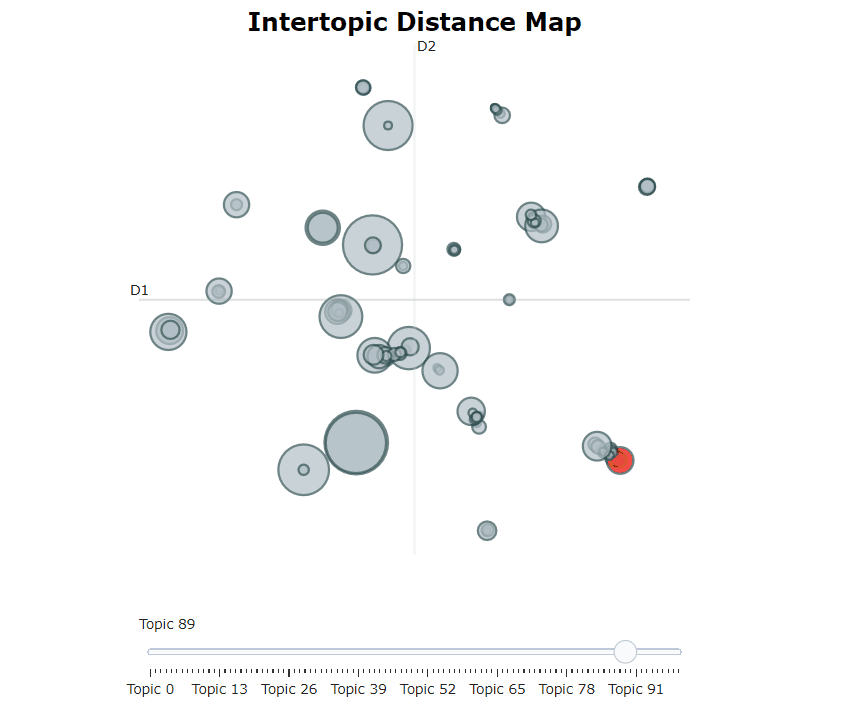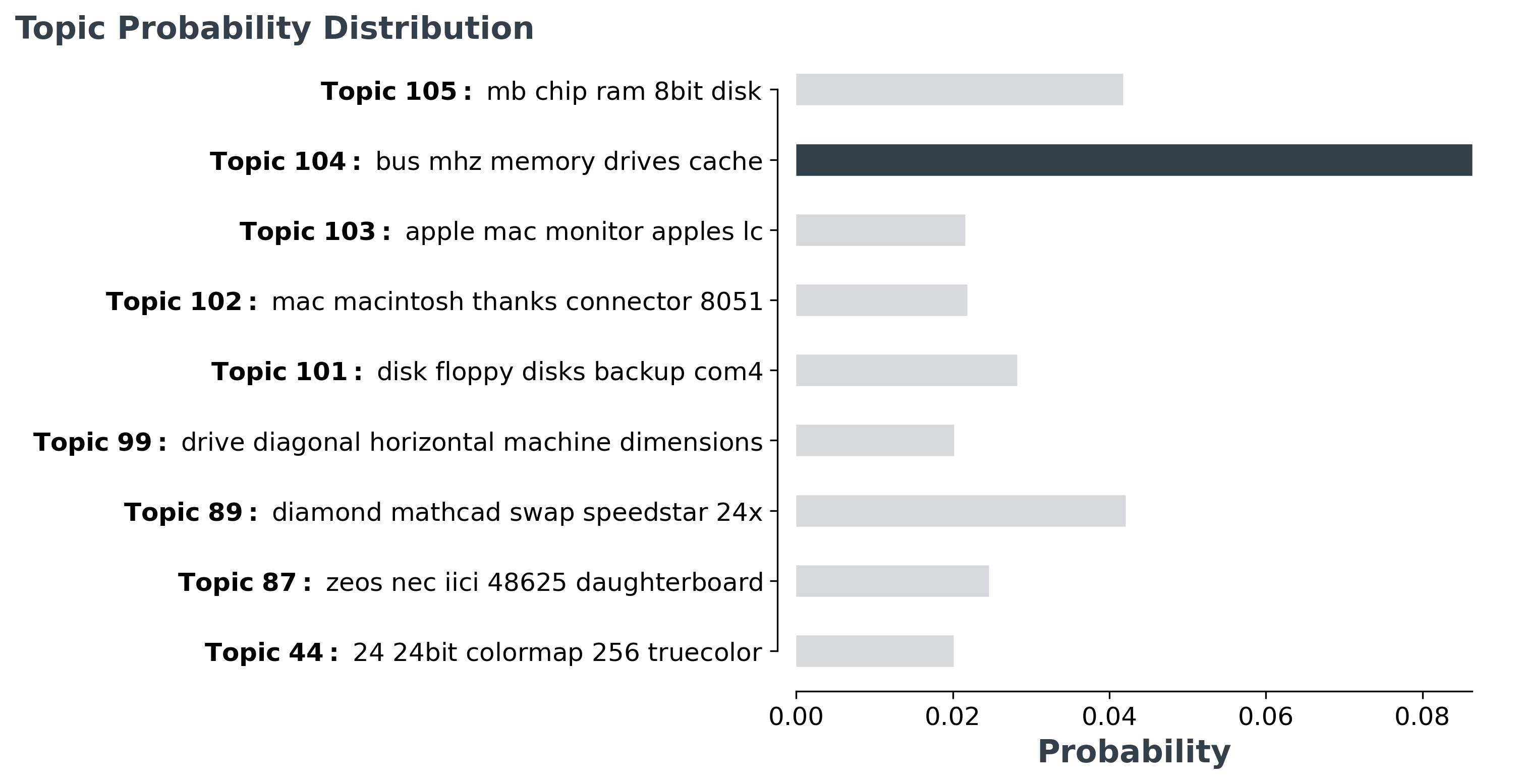BERTopic is a topic modeling technique that leverages 🤗 transformers and c-TF-IDF to create dense clusters allowing for easily interpretable topics whilst keeping important words in the topic descriptions. It even supports visualizations similar to LDAvis!
Corresponding medium post can be found here.
Installation can be done using pypi:
pip install bertopicTo use the visualization options, install BERTopic as follows:
pip install bertopic[visualization]Installation Errors
PyTorch 1.4.0 or higher is recommended. If the install gives an error, please install pytorch first here.
For an in-depth overview of the features of BERTopic
you can check the full documentation here or you can follow along
with the Google Colab notebook here.
We start by extracting topics from the well-known 20 newsgroups dataset which is comprised of english documents:
from bertopic import BERTopic
from sklearn.datasets import fetch_20newsgroups
docs = fetch_20newsgroups(subset='all', remove=('headers', 'footers', 'quotes'))['data']
model = BERTopic(language="english")
topics, probabilities = model.fit_transform(docs)After generating topics and their probabilities, we can access the frequent topics that were generated:
>>> model.get_topic_freq().head()
Topic Count
-1 7288
49 3992
30 701
27 684
11 568-1 refers to all outliers and should typically be ignored. Next, let's take a look at the most
frequent topic that was generated, topic 49:
>>> model.get_topic(49)
[('windows', 0.006152228076250982),
('drive', 0.004982897610645755),
('dos', 0.004845038866360651),
('file', 0.004140142872194834),
('disk', 0.004131678774810884),
('mac', 0.003624848635985097),
('memory', 0.0034840976976789903),
('software', 0.0034415334250699077),
('email', 0.0034239554442333257),
('pc', 0.003047105930670237)]Supported Languages
Use "multilingual" to select a model that supports 50+ languages.
Moreover, the following languages are supported:
Afrikaans, Albanian, Amharic, Arabic, Armenian, Assamese, Azerbaijani, Basque, Belarusian, Bengali, Bengali Romanize, Bosnian, Breton, Bulgarian, Burmese, Burmese zawgyi font, Catalan, Chinese (Simplified), Chinese (Traditional), Croatian, Czech, Danish, Dutch, English, Esperanto, Estonian, Filipino, Finnish, French, Galician, Georgian, German, Greek, Gujarati, Hausa, Hebrew, Hindi, Hindi Romanize, Hungarian, Icelandic, Indonesian, Irish, Italian, Japanese, Javanese, Kannada, Kazakh, Khmer, Korean, Kurdish (Kurmanji), Kyrgyz, Lao, Latin, Latvian, Lithuanian, Macedonian, Malagasy, Malay, Malayalam, Marathi, Mongolian, Nepali, Norwegian, Oriya, Oromo, Pashto, Persian, Polish, Portuguese, Punjabi, Romanian, Russian, Sanskrit, Scottish Gaelic, Serbian, Sindhi, Sinhala, Slovak, Slovenian, Somali, Spanish, Sundanese, Swahili, Swedish, Tamil, Tamil Romanize, Telugu, Telugu Romanize, Thai, Turkish, Ukrainian, Urdu, Urdu Romanize, Uyghur, Uzbek, Vietnamese, Welsh, Western Frisian, Xhosa, Yiddish
After having trained our BERTopic model, we can iteratively go through perhaps a hundred topic to get a good
understanding of the topics that were extract. However, that takes quite some time and lacks a global representation.
Instead, we can visualize the topics that were generated in a way very similar to
LDAvis:
model.visualize_topics()The variable probabilities that is returned from transform() or fit_transform() can
be used to understand how confident BERTopic is that certain topics can be found in a document.
To visualize the distributions, we simply call:
# Make sure to input the probabilities of a single document!
model.visualize_distribution(probabilities[0])You can select any model from sentence-transformers and pass it through
BERTopic with embedding_model:
from bertopic import BERTopic
model = BERTopic(embedding_model="xlm-r-bert-base-nli-stsb-mean-tokens")You can also use previously generated embeddings by passing it through fit_transform():
model = BERTopic()
topics, probabilities = model.fit_transform(docs, embeddings)Click here for a list of supported sentence transformers models.
| Methods | Code |
|---|---|
| Fit the model | model.fit(docs]) |
| Fit the model and predict documents | model.fit_transform(docs]) |
| Predict new documents | model.transform([new_doc]) |
| Access single topic | model.get_topic(12) |
| Access all topics | model.get_topics() |
| Get topic freq | model.get_topic_freq() |
| Visualize Topics | model.visualize_topics() |
| Visualize Topic Probability Distribution | model.visualize_distribution(probabilities[0]) |
| Update topic representation | model.update_topics(docs, topics, n_gram_range=(1, 3)) |
| Reduce nr of topics | model.reduce_topics(docs, topics, probabilities, nr_topics=30) |
| Find topics | model.find_topics("vehicle") |
| Save model | model.save("my_model") |
| Load model | BERTopic.load("my_model") |
To cite BERTopic in your work, please use the following bibtex reference:
@misc{grootendorst2020bertopic,
author = {Maarten Grootendorst},
title = {BERTopic: Leveraging BERT and c-TF-IDF to create easily interpretable topics.},
year = 2020,
publisher = {Zenodo},
version = {v0.4.2},
doi = {10.5281/zenodo.4430182},
url = {https://doi.org/10.5281/zenodo.4430182}
}






